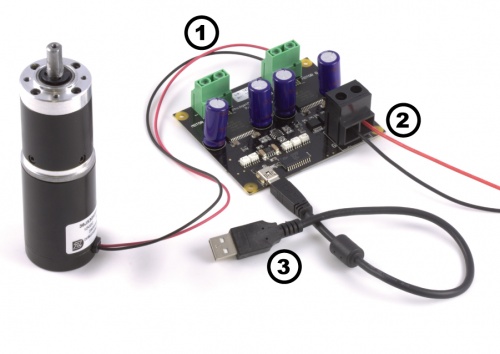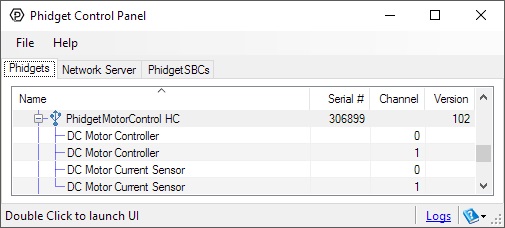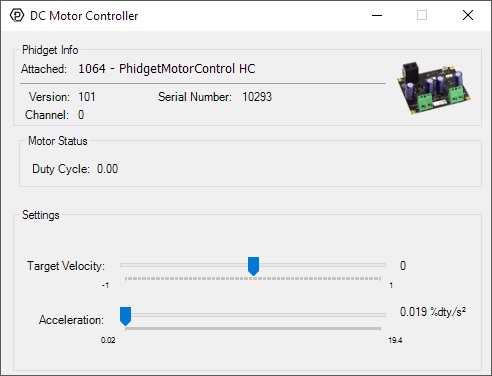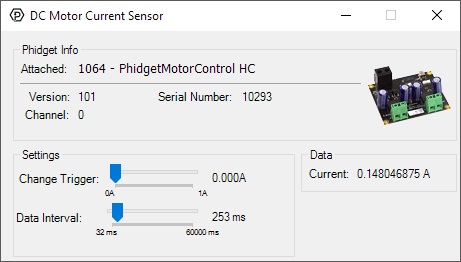Replaced by the 1064 - PhidgetMotorControlHC.
The PhidgetMotorControl HC allows you to control the angular velocity and acceleration of up to two high-current DC motors.
Many variations of brushed DC motors exist: permanent magnet motors, electromagnet motors, coreless motors, linear motors... the PhidgetMotorController can be used with any of these, as well as other devices like small solenoids, incandescent light bulbs, and hydraulic or pneumatic devices like small pumps and valves.
| Characteristic | Value |
|---|---|
| Output Controller Update Rate | 50 updates/second |
| Velocity Resolution | 1.5% |
| Acceleration Resolution | 1.5% Velocity/Second2 |
| Acceleration Limit (-100% to +100% velocity) | 120ms |
| PWM Frequency | 20kHz |
| Minimum Power Supply Voltage | 6VDC |
| Maximum Power Supply Voltage | 15VDC |
| Continuous Motor Current | 14A |
| Peak Motor Current - 60 seconds | 19A |
| Peak Motor Current - 10 seconds | 25A |
| Peak Motor Current - 2 seconds | 32 |
| Motor Overcurent Trigger on Load | < 100mΩ (50A typical) |
| Device Active Current Consumption | 100mA max |
| Operating Temperature | 0 - 70°C |
| Device | Object Name | Channel |
|---|---|---|
| DC Motor Output | DCMotor | 0 - 2 |
If you need a DC motor, we do carry a selection:
Comes packaged with
| API | Detail | Language | OS | |
|---|---|---|---|---|
| DCMotor | Visual Studio GUI | C# | Windows | Download |
| DCMotor | JavaScript | Browser | Download | |
| DCMotor | Objective-C | macOS | Download | |
| DCMotor | Swift | macOS | Download | |
| DCMotor | Swift | iOS | Download | |
| DCMotor | Visual Basic .NET | Windows | Download | |
| DCMotor | Max/MSP | Multiple | Download | |
| CurrentInput | Visual Studio GUI | C# | Windows | Download |
| CurrentInput | JavaScript | Browser | Download | |
| CurrentInput | Objective-C | macOS | Download | |
| CurrentInput | Swift | macOS | Download | |
| CurrentInput | Swift | iOS | Download | |
| CurrentInput | Visual Basic .NET | Windows | Download | |
| CurrentInput | Max/MSP | Multiple | Download |
| Date | Board Revision | Device Version | Comment |
|---|---|---|---|
| October 2007 | 0 | 100 | Product Release |
| May 2009 | 0A | 101 | Improved PWM Opto-isolators |
| May 2009 | 0A | 102 | Fixed acceleration bug |
| July 2011 | 1 | 102 | Switch to Mini-USB connector |
Welcome to the 1064 user guide! In order to get started, make sure you have the following hardware on hand:
Next, you will need to connect the pieces:

Now that you have everything together, let's start using the 1064!
In order to demonstrate the functionality of the 1064, the Phidget Control Panel running on a Windows machine will be used.
The Phidget Control Panel is available for use on both macOS and Windows machines.
To open the Phidget Control Panel on Windows, find the ![]() icon in the taskbar. If it is not there, open up the start menu and search for Phidget Control Panel
icon in the taskbar. If it is not there, open up the start menu and search for Phidget Control Panel
To open the Phidget Control Panel on macOS, open Finder and navigate to the Phidget Control Panel in the Applications list. Double click on the ![]() icon to bring up the Phidget Control Panel.
icon to bring up the Phidget Control Panel.
For more information, take a look at the getting started guide for your operating system:
Linux users can follow the getting started with Linux guide and continue reading here for more information about the 1064.
After plugging the 1064 into your computer and opening the Phidget Control Panel, you will see something like this:

The Phidget Control Panel will list all connected Phidgets and associated objects, as well as the following information:
The Phidget Control Panel can also be used to test your device. Double-clicking on an object will open an example.
Double-click on the DC Motor object, labelled DC Motor Controller, in order to run the example:

General information about the selected object will be displayed at the top of the window. You can also experiment with the following functionality:
Double-click on the Current Input object , labelled DC Motor Current Sensor, in order to run the example:

General information about the selected object will be displayed at the top of the window. You can also experiment with the following functionality:
Before you can access the device in your own code, and from our examples, you'll need to take note of the addressing parameters for your Phidget. These will indicate how the Phidget is physically connected to your application. For simplicity, these parameters can be found by clicking the button at the top of the Control Panel example for that Phidget.

In the Addressing Information window, the section above the line displays information you will need to connect to your Phidget from any application. In particular, note the Channel Class field as this will be the API you will need to use with your Phidget, and the type of example you should use to get started with it. The section below the line provides information about the network the Phidget is connected on if it is attached remotely. Keep track of these parameters moving forward, as you will need them once you start running our examples or your own code.

You are now ready to start writing your own code for the device. The best way to do that is to start from our Code Samples.
Select your programming language of choice from the drop-down list to get an example for your device. You can use the options provided to further customize the example to best suit your needs.
Once you have your example, you will need to follow the instructions on the page for your programming language to get it running. To find these instructions, select your programming language from the Programming Languages page.
For more information about DC motors and how to control them, check the DC Motor and Controller Guide.
| Channel Name | API | Channel |
|---|---|---|
| DC Motor Controller | DCMotor | 0 - 1 |
| DC Motor Current Sensor | CurrentInput | 0 - 1 |